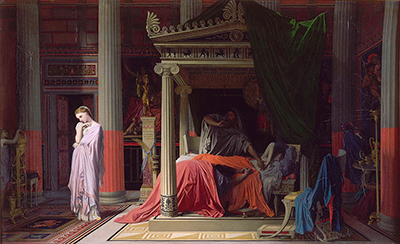Antiochus and Stratonice is an 1840 work-of-art created by the French painter Jean-Auguste-Dominique Ingres. The painting was first displayed in the gallery at the Royal Palace and was later inherited by Hélène de Mecklembourg-Schwerin, who was the widow of Prince Ferdinand Phillipe. Today, the painting is housed at the Musée Condé in Chantilly.
Commissioning
Antiochus and Stratonice was commissioned by Prince Ferdinand Phillipe, who was the Duke of Orléans, in 1834. It was supposed to complement the painting The Assassination of the Duke of Guise made by Paul Delaroche in 1834. Because Ingres had to go to Rome in 1834 as he was appointed Director of the French Academy, the painting was delayed until 1838. Lady Egle Charlemont served as the model for Stratonice. Ingres' wife served as the model for the doctor. Hyppolyte Flandrin was used as a model for Antiochus' body and Ingres used himself for Seleucus. The painting was finished in 1840, in Rome, with the assistance of Victor Baltard and Raymond and Paul Balze.
The Plot
The ancient story of Antiochus and Stratonice offered Ingres the mix eroticism with classicism. Seleucus was the ruler of the provinces in Asia after Alexander the Great's death. Antiochus, who was Seleucus' son, fell in love with his stepmother Stratonice. Because he believed his love for her was hopeless, he looked for a way to commit suicide. So, he starved himself and became ill. The Court's doctor, Erasistratus, identified the cause of his illness as he observed Antiochus' reaction when Stratonice approached. Erasistratus told Seleucus about the real cause of his son's illness. Seleucus decided to abdicate and offer his kingdom to his son along with his wife.
The scene takes place in Antiochus's bedroom. He lies half-naked on the bed, struggling for his life. The doctor feels his heart racing once the young man sees Stratonice, who is wearing rich garments. She's painted in soft and light colours, with her head tilted as though she's feeling Antiochus' pain. The young man is covered by a red sheet, which amplifies the depth of his suffering. The bed is prestigious, with two columns. It helps reflect how Antiochus' feels, trapped in his hopeless love. The painting seems to be divided by light and darkness.
Ingres uses dark and strong colours when painting Antiochus, the doctor, and the bed. But Stratonice appears in light colours. She represents Antiochus' hope to live. Her proximity to a strong column supports the theory. Antiochus and Stratonice describes a scene from "Life of Demetreus" by Plutarch. It defines a father's devotion and love for his son. Seleucus sacrifices his power and love for Antiochus, his son. The subject of the painting is both an example of parental devotion but also an intense love story.




